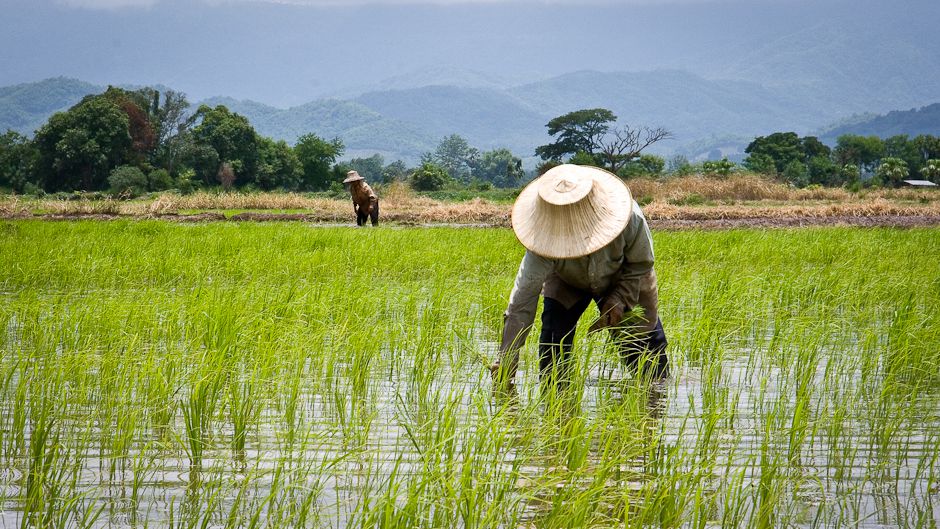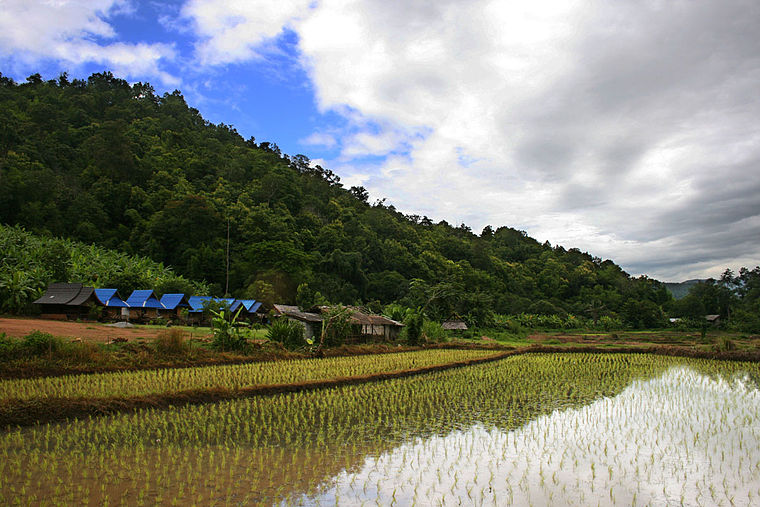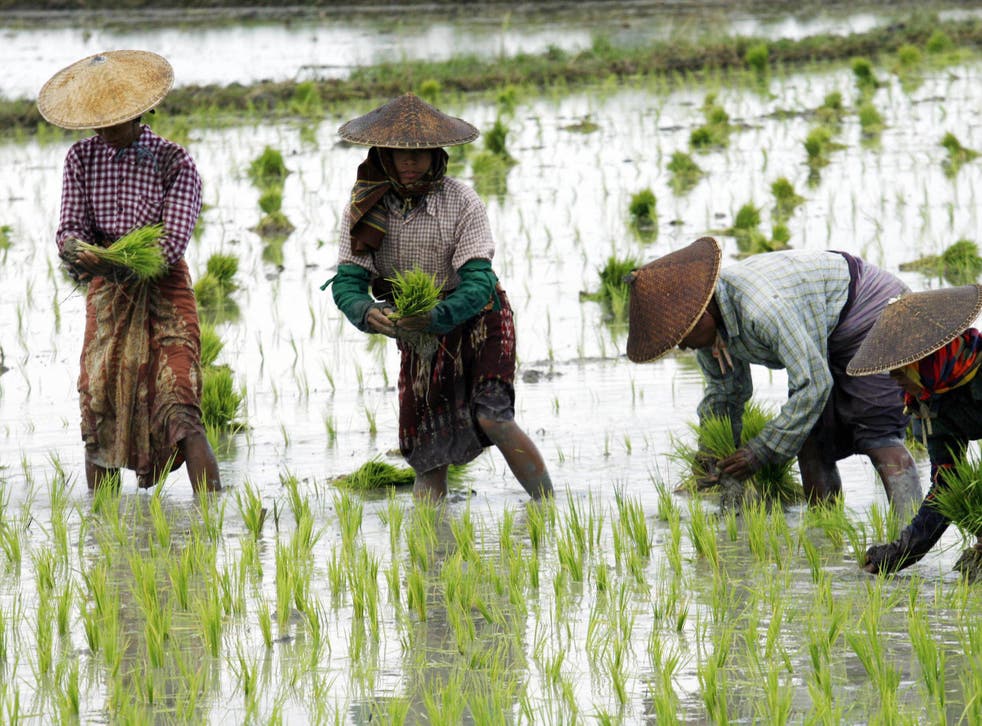Rice growing produces methane gas by feeding microbes that live under the rice paddies. Methane production in a rice field CH 4 in rice fields are generally produced from the successive breakdown of complex organic matter ie.

More Rice Less Methane Greenhouse Gas Emissions Methane Water Conservation
Livestock accounts for up to half of emissions in agriculture.
How does rice farming produce methane. Flooded rice Oryza sativa L cultivation has been identified as one of the leading global agricultural sources of anthropogenic methane CH4 emissions. AGRICULTURE 456 Revised 1996 IPCC Guidelines for National Greenhouse Gas Inventories. The warm waterlogged soil of rice paddies provides ideal conditions for methanogenesis and though some of the methane produced is usually oxidized by methanotrophs in the shallow overlying water the vast majority is released into.
Methane is present at about only 18 parts per million in the atmosphere but is a key player there it is a greenhouse gas it is central to atmospheric oxidation. As more carbon dioxide enters the atmosphere rice plants grow faster the experimental data showed. Carbohydrates protein and lipids under anaerobic conditions.
On TV you are aware of how a rice field looks like. Rice is the worlds second biggest crop in terms of production. The main culprit is methane a potent greenhouse gas emitted from flooded rice fields as bacteria in the waterlogged soil produce it in large quantities.
Our experiments have tested the standard model of methane emissions from rice fields and found new results on the processes that control the flux. Organic amendments increase methane production and emission. Covered with water a rice field is not only a huge absorbent of fresh irrigation water but also an optimal environment for methane to thrive.
The longer the flooding lasts the more those bacteria build up. Furthermore it has been estimated that global rice production is responsible for 11 of total anthropogenic CH4 emissions. The water blocks oxygen from penetrating the soil creating ideal conditions for bacteria that emit methane.
Methane in rice paddies is produced by microscopic organisms that respire CO2 like humans respire oxygen. Rice grows mostly in flooded fields called rice paddies. Overall the rice paddy experiments revealed that increased carbon dioxide in the atmosphere boosted rice yields by.
A third major source of agricultural methane emissions arises from losses of organic matter in manures from both ruminant and non-ruminant livestock 3 total anthropogenic methane in 2012 and a small amount of methane is emitted from the burning of agricultural wastes 05. This growth in turn pumps up the metabolism of methane-producing microscopic organisms that live in the soil beneath rice paddies. Almost any farming method that reduces or interrupts the period of flooding can reduce methane.
Notably cows produce methane from digesting grass. In addition current climate mitigation strategies for rice production focus on reducing methane emissions by alternate wetting and drying or intermittent flooding. The production of one single kilo rice consumes up to 5000 liters of water.
For irrigated rice methane emissions calculated as a function of rice produced are higher in the dry season than in the wet season. Reference Manual TABLE 4-9 REPRESENTATIVE METHANE EMISSIONS FROM RICE PADDY FIELDS IN VARIOUS LOCATIONS OF THE WORLD Country Location Range of CH 4 flux mgm2hr Season total gm2 Experimental Treatment Reference Australia Griffith 28 10 - NGGIC 1996 China. Saunois said that while the reasons behind the methane surge are not well understood the most likely sources are cattle ranching and rice farming.
Various climatic soil water and culture factors can modify this general pattern. This can be reduced with new breeds of cattle that produce less methane and recently developed food additives that reduce dairy cow emissions by 30 without affecting milk yields. More CO 2 in the atmosphere makes rice.
More CO2 in the atmosphere makes. If you have ever seen a rice field in nature or eg. Most studies on the climate impacts of rice have measured methane emissions from continuously flooded rice farms.
The organic matter in rice field can be added from the terrestrial and aquatic weeds algal biomass the litter of rice plants rice stubbles microbial biomass aquatic animals and. Methane in rice paddies is produced by microscopic organisms that respire CO 2 like humans respire oxygen. Mechanisms and Processes Leading to Methane Emissions are Delineated.
Rice microbes and methane. Rice agriculture is one of the most significant human-created sources of methane gas. A mathematical mass balance model was used to unravel the production oxidation and transport of methane from rice.
Considering that CH4 has a global warming potential that is approximately 25 times more potent on a mass basis than. In a world affected by climate change growing rice is becoming less and less environmentally friendly.

Paddy Rice Production Climate Clean Air Coalition

Thailand S Rice Farmers Adapt To Climate Change Our World

In Addressing Climate Change Rice Production Needs More Attention And Urgent Action Opinion Eco Business Asia Pacific

Rice Production In Thailand Wikiwand

Rice Farming Has A Surprisingly Harmful Environmental Impact Earth Com

How Vietman S Rice Production Is Becoming More Efficient World Economic Forum

Rice Farming Up To Twice As Bad For Climate Change As Previously Thought Study Reveals The Independent The Independent
Existing Rice Production Sustainability Of Rice Production
/GettyImages-1208926057-41e3b282ce174537a707c5cbfcc8b736.jpg)
Rice Growing Emits More Methane As Climate Warms

0 comments:
Post a Comment